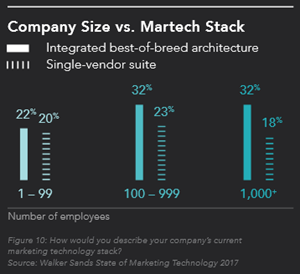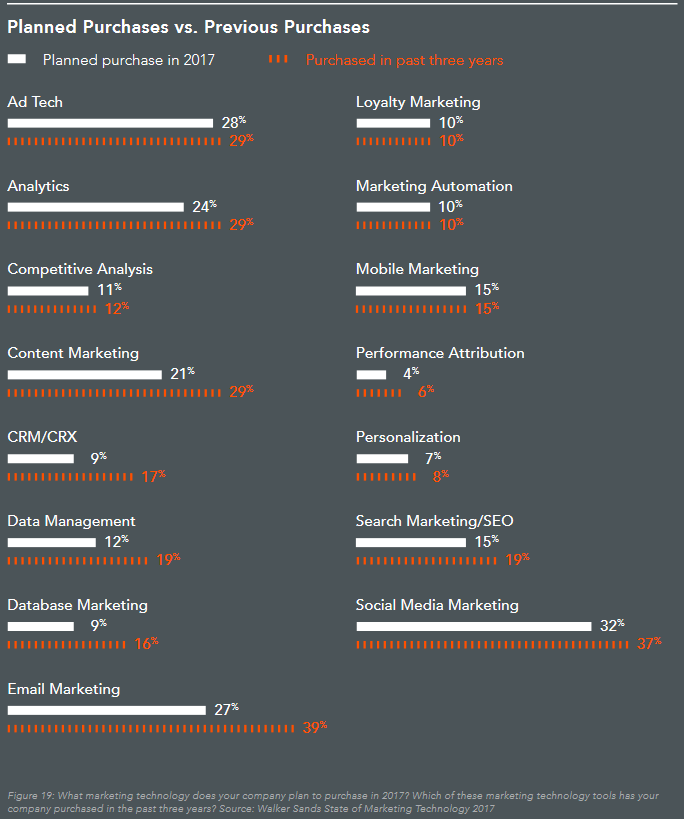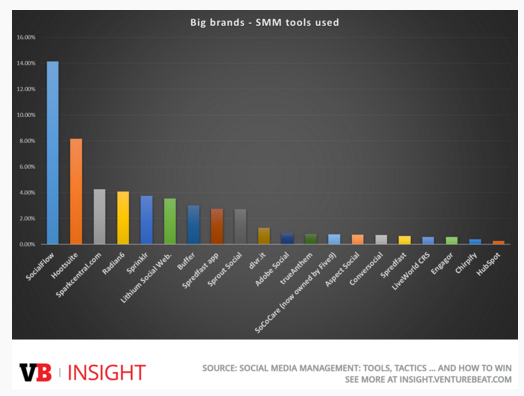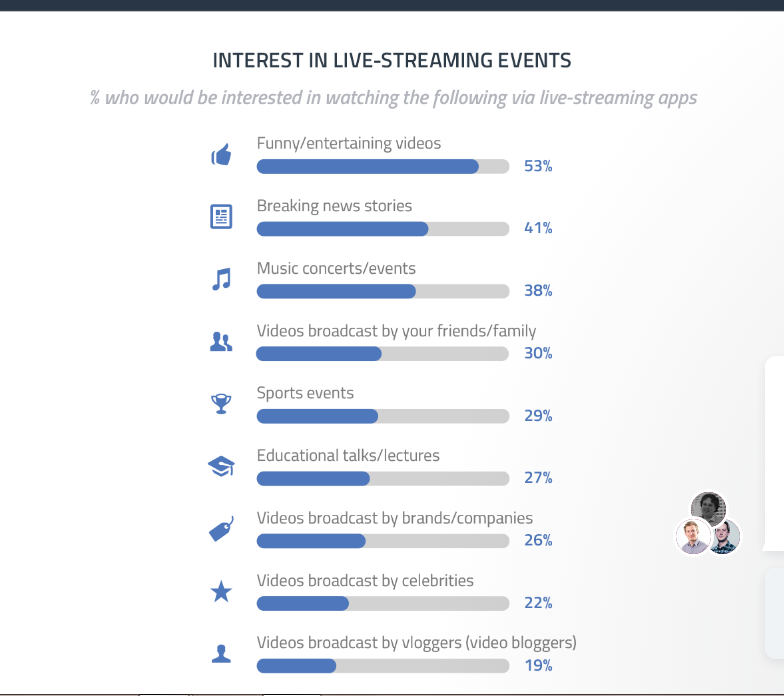Marketing Technology Adoption and Investment in 2017
A Walker Sands study with 335 U.S. marketers on the subject of marketing technology adoption unveiled that more than double the number of marketers now call their companies innovators or early adopters in marketing technology adoption compared to a year ago. To be exact, it went up to 48 percent from 20 percent. Furthermore, Gartner’s 2016-2017 CMO Spend Survey suggests that CMOs are now spending nearly as much on technology as their CIO counterparts, and, in 2017, CMO marketing tech spending seems to be on track to exceed the CIO technology spend. The fact that companies and marketers have made up so much ground in recent years inspired me to put some insights together on what we’ll see as priorities for marketing technology adoption and investment in 2017:
Embracing Best-of-Breed Architecture
What is most striking to me from the report conducted by Walker Sands, is that almost half of marketers (48 percent) describe their marketing technology stacks as best-of-breed, with the majority of those marketers (57 percent) calling their architecture “integrated” rather than “fragmented.” Additionally, only 21% of the participants use a single-vendor suite and a small number are developing their own proprietary marketing technology, also known as “dark martech.”
percent) describe their marketing technology stacks as best-of-breed, with the majority of those marketers (57 percent) calling their architecture “integrated” rather than “fragmented.” Additionally, only 21% of the participants use a single-vendor suite and a small number are developing their own proprietary marketing technology, also known as “dark martech.”
The findings also demonstrate that larger organizations tend to take advantage of more best-of-breed architecture compared to the smaller companies. The reason why marketers embrace best-of-breed architecture is that they feel more comfortable adding more tools into their ecosystem as they believe, they get the most out of their martech tools in that way. Also, this approach puts marketers in a position once handled by only IT so it creates a more democratized environment than ever, as marketers now need to manage software and even act like software developers if needed. Actually, the study cites that marketing technology is owned by the end business users, not IT—87 percent of the time.
With new solutions coming to market all the time, marketers feel like it gets much easier for marketers to jump from one solution to another, as the findings show for planned marketing technology investments in 2017. On the other hand, 56 percent of companies can’t keep up with the pace of change in the martech industry—and only 9 percent of marketers say their companies are outpacing the industry when it comes to technology adoption.
Data and Analytics Investment
Andrew Frank, Vice President, Research and Distinguished Analyst at Gartner, concluded that Adobe, Google, IBM, Oracle and Salesforce have the highest number of installations in place across nearly a quarter of the categories of martech, which are Data and analytics solutions; web operations solutions; content and customer experience solutions; advertising solutions; and direct marketing and marketing management solutions, in the survey. However, these five big vendors, collectively account for only 36 percent of all reported installations. When he looked at the categories individually, interestingly, he found out that the categories like mobile marketing analytics, data visualization, SEM/SEO tools, ad verification services, and retargeting have not reported deployments from any of these five strong vendors. I would say therein lies the opportunity for the vendors.
The same study also found that more than 70% are currently deploying or committed to deployments of the detailed analytics and real-time experience management. Gartner’s 2016-2017 CMO Spend Survey also unveiled that as a stand-alone spending category, marketing analytics represents the fourth highest share of the budget. On an interesting note, marketers in the consumer packaged goods (CPG) industry invest more in marketing analytics technology than all the other respondents. According to Gartner, the driving factor behind this pattern is a need to leverage consumer insight.
With the rise of data-centricity, the adoption of data visualization tools will significantly accelerate this year. After all, analytics is one of the most prominent pieces of marketing technologies as without tapping into the results powered by them, all the marketing efforts are almost randomly executed. Data and analytics light up the map so marketers can navigate these daunting waters. In fact, in Walker Sands’ study, while most marketers responded that they are satisfied with the value they’re getting from their martech stacks, only 3 percent say they’re getting full value. When the study digs deeper into the reason Marketers most commonly cite a lack of technology strategy (39 percent), analytics (36 percent), and training (33 percent) as standing in the way of them fully harnessing the power of their tools.
Social Media Tools
With regard to the most popular martech for 2017, when we put the data from the Walker Sands’ study together, we get an interesting story. According to the survey, a full third of those surveyed said that they planned to buy a social media management solution during the next year, followed by ad tech (28 percent), email marketing (27 percent), analytics (24 percent), and content marketing (21 percent). Additionally, more than 50 percent of marketers who plan to purchase social media marketing (62 percent), email marketing (61 percent), content marketing (58 percent), ad tech (56 percent), and analytics (50 percent) tools in 2017 have already done so in the past three years. What this picture tells us is that social media solutions have been frequently purchased either because of marketers’ changing needs or their dissatisfaction with the existing solutions. The chart below illustrates the overlap between the technologies that marketers plan to purchase in 2017 and the most commonly purchased tools of the past three years:

According to Venture Beat’s study titled Social Media Management: Tools, tactics… and How to Win, Gen-X does more research online and via social media than other generations and is the fastest growing demographic among social networks and have a higher net worth than those younger than them. The chart below illustrates that the most popular SMM tools:

Social media tools used to be utilized to amplify brands’ products and messaging but finally, marketers have realized that those tools could provide much more value when they are used as a customer-focused platform listening to customer conversations online. As a result, a software provider for instance, can take the guesswork out of product development and launch more relevant products and services.
Tools for Real-time Customer Interactions
Content streaming is becoming imperative when it comes to engaging with your target audience. If your business is under-resourced or not the best candidate for some other reasons, there are so many indirect ways like sponsorship and affiliations. The rise of media engagement technology enables the brand to stream content contemporaneously through all the relevant channels, in real time that is often referred to at the right time. Tools driving real-time customer interactions are poised for remarkable blooming in 2017 as many brands have already allocated the budget to invest in. With regard to content streaming, live video streaming seems to have made a splash this year. Here’s an interesting statistic on the current interest in content provided through live-streaming apps:

(Source: GlobalwebIndex)
The magic that real-time marketing tools make is developing a contextual understanding of customers, and one way of making it possible is the account-based marketing (ABM) approach which is a strategic go-to-market approach and creates more specific, relevant, and personalized interactions to drive engagement and conversion at a targeted set of accounts or expand existing ones. Therefore, ABM is expected to be a key element in many companies’ 2017 marketing strategy. In fact, according to Frost&Sullivan, 80% of marketers measuring ROI say that ABM outperforms other marketing investments. Another recent study conducted by SiriusDecisions concluded that 92% of B2B companies call ABM “extremely important” to their overall marketing efforts, while 60% plan to invest in ABM in the next year.
“To break down walls between sales and marketing, ABM is pretty close to a silver bullet in that it aligns programs’ dollars and focus on the accounts that the sales teams care about. So there's inherent buy-in. That said, ABM is only as good as your visibility into your highest potential accounts and best-fit customer segments, which gets clearer over time. So it’s most effective when deployed as part of a comprehensive set of targeting strategies,” said Dave Karel, Head of B2B Marketing, LinkedIn Marketing Solutions.
Bottom Line
In the age of technology innovation and disruption, companies are consistently looking for the next big thing. To me, it is very interesting to see that on one hand, half of marketers admit that they can’t keep up with the changes happening at light speed in the martech space, but on the other hand, almost half of them call their companies innovators or early adopters in marketing technology adoption. I do not think that marketers are looking at the situation through rose-colored glasses but it definitely shows a high level of optimism which is not a bad attitude at all. However, more importantly, my interpretation here is that companies and marketers are in an experimental stage where they are extremely driven to try out new technologies but often find themselves overwhelmed by the pace of innovation. Therefore, the vendors who make innovations that save marketers from their treadmill by lowering up-front and switching costs as well as providing high compatibility of their product are most likely to win their vote this year. Nevertheless, increasing optimism and budget will certainly make it possible to see more exciting improvements shaping the martech space.

Venus Tamturk
Venus is the Media Reporter for CMS-Connected, with one of her tasks to write thorough articles by creating the most up-to-date and engaging content using B2B digital marketing. She enjoys increasing brand equity and conversion through the strategic use of social media channels and integrated media marketing plans.